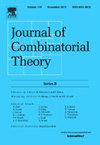Weak saturation in graphs: A combinatorial approach
IF 1.2
1区 数学
Q1 MATHEMATICS
引用次数: 0
Abstract
The weak saturation number is the minimum number of edges in a graph on n vertices such that all the missing edges can be activated sequentially so that each new edge creates a copy of F. In contrast to previous algebraic approaches, we present a new combinatorial approach to prove lower bounds for weak saturation numbers that allows to establish worst-case tight (up to constant additive terms) general lower bounds as well as to get exact values of the weak saturation numbers for certain graph families. It is known (Alon, 1985) that, for every F, there exists such that . Our lower bounds imply that all values in the interval with step size are achievable by for graphs F with minimum degree δ (while any value outside this interval is not achievable).
图中的弱饱和:一种组合方法
弱饱和数wsat(n,F)是在n个顶点上的图中所有缺失边可以依次激活的最小边数,以便每个新边创建一个F的副本。我们提出了一种新的组合方法来证明弱饱和数的下界,这种方法允许建立最坏情况下的紧(直至常数加性项)一般下界,并得到某些图族的弱饱和数的精确值。众所周知(Alon, 1985),对于每一个F,存在cF使得wsat(n,F)=cFn(1+o(1))。我们的下界意味着步长为1δ+1的区间[δ2−1δ+1,δ−1]中的所有值都可以通过cF实现,对于最小度为δ的图F(而任何超出此区间的值都不可实现)。
本文章由计算机程序翻译,如有差异,请以英文原文为准。
求助全文
约1分钟内获得全文
求助全文
来源期刊
CiteScore
2.70
自引率
14.30%
发文量
99
审稿时长
6-12 weeks
期刊介绍:
The Journal of Combinatorial Theory publishes original mathematical research dealing with theoretical and physical aspects of the study of finite and discrete structures in all branches of science. Series B is concerned primarily with graph theory and matroid theory and is a valuable tool for mathematicians and computer scientists.

 求助内容:
求助内容: 应助结果提醒方式:
应助结果提醒方式:


